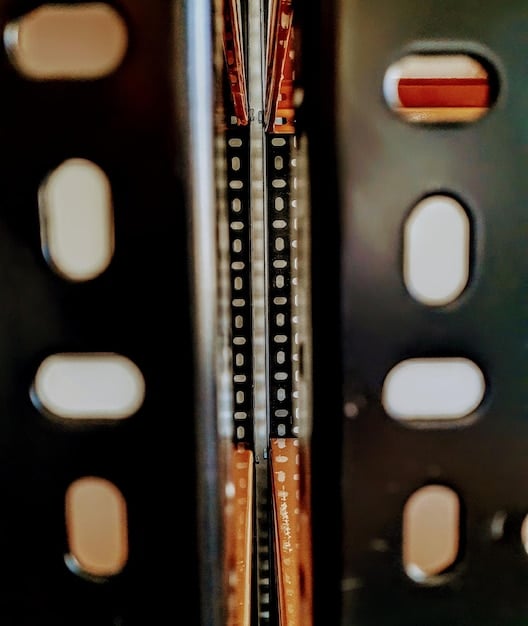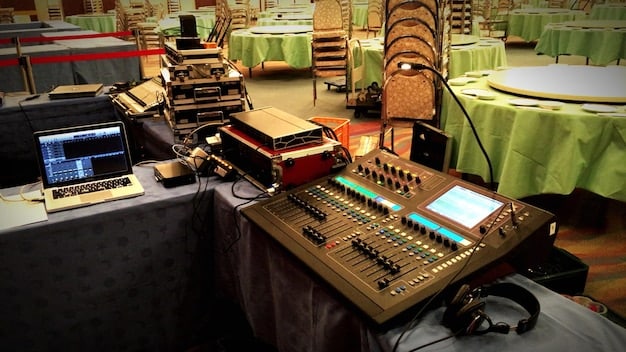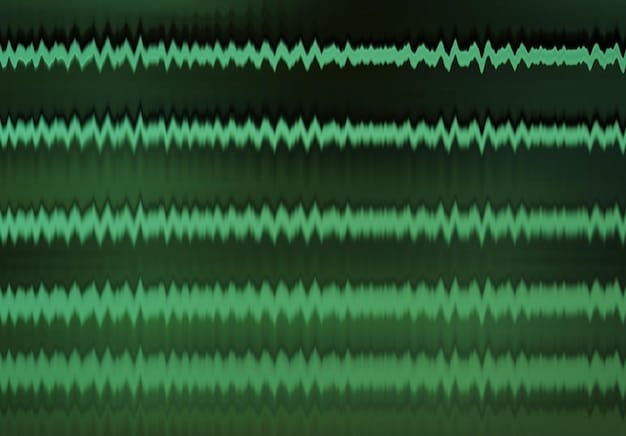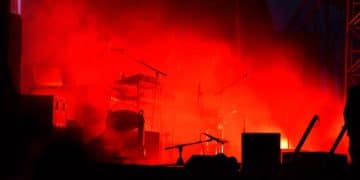Industrial Metal Sound Design: Synthesizers and Dystopian Atmospheres

Industrial metal sound design utilizes synthesizers and various audio manipulation techniques to craft dark, aggressive, and often dystopian atmospheres, blending the raw power of metal with electronic textures.
The relentless pulse of industrial metal fused with the synthetic textures of synthesizers creates vivid sonic landscapes for the listener. Industrial metal sound design: creating dystopian atmospheres with synthesizers is a potent combination that has shaped the sound of countless bands and influenced entire subgenres. Let’s delve into how these dystopian worlds are built, brick by distorted brick.
Exploring the Foundations of Industrial Metal Sound
Industrial metal emerged as a collision of heavy metal’s aggression and the experimental nature of industrial music. It’s a genre where sonic textures reflecting urban decay, technological advancement, and societal breakdown are as crucial as the riffs themselves. The core of this lies in sound design, where crafting unique and unsettling soundscapes becomes the ultimate goal.
The Influence of Early Industrial Music
Early industrial bands like Throbbing Gristle and Einstürzende Neubaten pioneered the use of unconventional sounds. They manipulated found objects, utilized tape loops, and embraced chaotic noise to create a sonic palette unheard of at the time.
Metal’s Adaptation of Industrial Textures
Metal bands began to incorporate these industrial textures to add a new dimension to their sound, layering metallic percussion, distorted samples, and synthesized soundscapes over traditional metal instrumentation.
- Noise as an Instrument: Embracing noise and distortion as integral parts of the musical composition.
- Sampling and Found Sounds: Incorporating samples of machinery, factory noises, and other urban sounds into the music.
- Experimentation with Effects: Using a wide range of effects to manipulate and distort sounds, creating unique textures.
The use of sampling and unconventional sound sources became a hallmark of industrial metal, helping to define its distinct sonic identity.

Synthesizers: The Palette of Dystopian Soundscapes
Synthesizers are indispensable tools in industrial metal sound design, providing a means to generate and manipulate a vast array of dystopian and futuristic sounds. They enable musicians to craft the textures and atmospheres essential for creating immersive and unsettling sonic environments.
Analog vs. Digital Synthesizers
Analog synthesizers offer a raw, warm sound that is often favored for creating gritty and distorted textures, while digital synthesizers provide precision and versatility for complex sound design.
Modular Synthesizers and Sound Design
Modular synthesizers offer boundless possibilities for creating unique sounds. Patch cables allow you to route signals in complex ways, creating intricate and evolving textures.
- Creating Basslines: Using subtractive synthesis to create heavy, distorted bass lines that drive the music.
- Designing Pads and Atmospheres: Crafting atmospheric pads and drones with long attack and release times, often incorporating chorus, reverb, and delay effects.
- Generating Percussive Sounds: Designing unique percussive sounds by combining oscillators, filters, and envelopes.
The versatility of synthesizers allows industrial metal artists to create the eerie and unsettling atmospheres that define the genre, blending organic metal elements with synthetic textures.
Common Synthesizer Techniques in Industrial Metal
Several synthesizer techniques are frequently employed to achieve the genre’s signature sound. From aggressive basslines to eerie soundscapes, these methods provide the building blocks for constructing sonic worlds that are both captivating and disturbing.
Subtractive Synthesis for Aggressive Sounds
Subtractive synthesis, which involves filtering harmonics from a harmonically rich waveform, is used to create aggressive and distorted sounds.
Frequency Modulation (FM) for Metallic Tones
FM synthesis modulates the frequency of one oscillator with another, producing metallic and dissonant tones often used for creating harsh textures.
- Filter Sweeps: Creating dynamic movement by sweeping a filter’s cutoff frequency.
- LFO Modulation: Using Low-Frequency Oscillators (LFOs) to modulate parameters like pitch, volume, and filter cutoff for evolving textures.
- Envelope Shaping: Shaping the attack, decay, sustain, and release (ADSR) of sounds to create dynamic and percussive effects.
Mastering these techniques enables sound designers to craft unique tones and soundscapes that enhance the intensity and atmosphere of their compositions.

Effects Processing: Sculpting the Industrial Sound
Effects processing plays a pivotal role in shaping the sound of industrial metal. By using a combination of distortion, reverb, delay, and other effects, sound designers can transform raw synthesized sounds into complex, textured, and often overwhelming sonic landscapes.
Distortion and Overdrive
Distortion and overdrive are essential for adding grit, aggression, and intensity to synthesized sounds, transforming them into the harsh textures synonymous with industrial metal.
Reverb and Delay
Reverb and delay can create the illusion of space and depth, enhancing the atmosphere and adding a sense of scale to the sound. Different types of reverb, such as plate, hall, and convolution reverb, can be used to create various spatial environments.
- Chorus and Flanger: Adding movement and texture to sounds, creating a sense of depth and complexity.
- Granular Synthesis: Manipulating sounds at a granular level to create unique textures and effects.
- Spectral Processing: Altering the spectral content of sounds to create unusual and unsettling effects.
Experimentation with different effects chains and configurations can lead to the discovery of new and innovative sounds, pushing the boundaries of sound design.
Software and Hardware Tools for Industrial Metal Sound Design
Modern industrial metal sound design relies on a combination of software and hardware tools. These resources provide artists with the capability to create, manipulate, and refine sounds to achieve their desired dystopian atmospheres.
DAWs and Plugins
Digital Audio Workstations (DAWs) like Ableton Live, Logic Pro X, and Cubase serve as the central hub for recording, editing, and mixing music. Plugins offer a vast array of virtual instruments, effects processors, and sound design tools.
Hardware Synthesizers and Effects Units
Hardware synthesizers offer a tactile and hands-on approach to sound design, providing immediate control over parameters and generating unique sonic characteristics. Analog effects units, such as guitar pedals and rack-mounted processors, can add warmth, character, and imperfections to the sound.
- Sampling Workstations: Machines optimized for sampling and manipulating audio, pivotal for incorporating found sounds and unusual textures.
- Midi Controllers: Devices that provide tactile control over virtual instruments and software parameters, enhancing the creative workflow.
- Acoustic Treatment: Essential for creating a controlled listening environment, ensuring accurate monitoring and mixing decisions.
By leveraging the strengths of both software and hardware, sound designers can create sounds and textures that blur the lines between the organic and the synthetic, adding to their creative arsenal.
The Future of Industrial Metal Sound Design
The landscape of industrial metal sound design is continuously evolving, driven by technological advancements and artistic innovation. New techniques and tools are constantly emerging, offering musicians fresh avenues for experimentation and expression.
Emerging Technologies
Developments in artificial intelligence (AI) and machine learning (ML) are opening up new possibilities for sound design. AI-powered plugins can analyze and generate sounds based on user input, while ML algorithms can create complex algorithmic effects.
The Fusion of Genres
Industrial metal is increasingly blending with other genres, such as electronic music, hip-hop, and experimental noise. This fusion creates new hybrid subgenres with unique sonic characteristics.
- Virtual Reality (VR): VR environments offer immersive spaces for creating and experiencing sound, enhancing the connection between the music and the listener.
- Generative Music: Algorithms and systems that create music autonomously, often incorporating user input and random elements.
- Biometric Sensors: Devices that translate biological data into musical parameters, allowing for deeply personal and expressive compositions.
The fusion of technology and artistry will continue to shape the future of industrial metal sound design, creating sonic landscapes that are more immersive, dynamic, and evocative than ever before.
| Key Element | Brief Description |
|---|---|
| 🔊 Synthesizers | Provide a foundation for creating distorted and aggressive sounds. |
| 🎸 Effects Processing | Sculpts the industrial sound by adding distortion, reverb, and delay. |
| 💻 Software Tools | DAWs and plugins enable recording, editing, and complex sound manipulation. |
| 🤖 AI Integration | Emerging AI technologies offer advanced sound generation and analysis features. |
Frequently Asked Questions
▼
Industrial metal sound design involves using synthesizers, distortion, and other effects to create dark, aggressive, and dystopian atmospheres. It blends metal with electronic textures.
▼
Both analog and digital synthesizers are popular. Analog synths provide a warm, gritty sound, while digital synths offer versatility and precision. Modular synths are favored for unique sound design.
▼
Distortion and overdrive are essential for adding aggression and intensity to synthesized sounds. They create the familiar harsh textures central to industrial metal, enhancing the overall impact.
▼
Reverb and delay create space and depth, contributing to the atmosphere and establishing scale. Different reverb types help construct diverse spatial environments, enhancing immersion.
▼
Yes, AI-powered plugins can analyze and generate sounds, while machine learning algorithms can create complex effects. These technologies offer new possibilities for sonic experimentation and expression.
Conclusion
The creation of dystopian atmospheres in industrial metal through the use of synthesizers and innovative sound design techniques represents a unique fusion of metal’s raw energy and electronic music’s experimental edge. As sound technology progresses, industrial metal is set to continue its evolution, remaining a powerful force in music.





